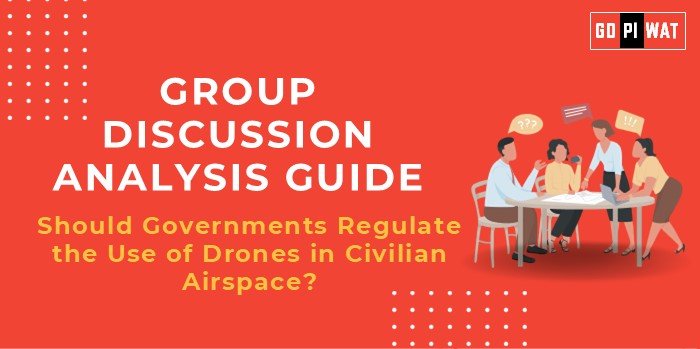📋 Group Discussion Analysis Guide
🚁 Should Governments Regulate the Use of Drones in Civilian Airspace?
🌟 Introduction to the Topic
Opening Context: The rise of drones, from recreational gadgets to tools for commercial and defense applications, has sparked debates worldwide. As drones become integral to industries like logistics, agriculture, and filmmaking, concerns about privacy, safety, and security have intensified.
Topic Background: The Federal Aviation Administration (FAA) and similar authorities worldwide have struggled to balance innovation with regulation. Recent incidents, such as near-misses with aircraft and unauthorized surveillance, have amplified the call for stricter controls.
📊 Quick Facts and Key Statistics
- Drone Market Growth: Valued at $22.5 billion in 2022, projected to reach $43 billion by 2028.
- Incidents: Over 1,600 unauthorized drone sightings near airports globally in 2023.
- Regulations: 85% of countries now have basic drone laws, but enforcement remains uneven.
- Employment Impact: Drones are expected to create 100,000 new jobs in logistics by 2025.
🏗️ Stakeholders and Their Roles
- Governments: Enact and enforce airspace regulations, ensure public safety.
- Drone Manufacturers: Innovate within compliance frameworks.
- Civil Aviation Authorities: Monitor and manage drone-aircraft integration.
- Private Sector: Utilize drones for delivery, surveillance, and analysis.
- Citizens: Advocate for privacy and safety while benefiting from drone applications.
🏆 Achievements and Challenges
- Achievements:
- Efficiency: Drones have reduced logistics costs by 30% in rural areas.
- Disaster Relief: Played a key role in delivering supplies post-earthquake in Turkey, 2023.
- Agriculture: Increased yields by 15% through precision farming in pilot projects.
- Challenges:
- Privacy Concerns: Unauthorized surveillance reported in 10% of urban deployments.
- Safety Risks: Increase in airspace collisions; over 200 incidents reported annually.
- Regulatory Lag: Disparities in legal frameworks across nations.
🌍 Global Comparisons and Case Studies
- United States: Advanced integration of drones in airspace but struggles with privacy issues.
- China: Leading in commercial drone applications but faces public resistance.
- Case Study: India’s “Drone Rules 2021” streamlined commercial use, fostering rapid industry growth.
🔍 Structured Arguments for Discussion
- Supporting Stance: “Regulation ensures safety and paves the way for innovation by addressing airspace conflicts and public concerns.”
- Opposing Stance: “Excessive regulation stifles innovation, making it difficult for startups to thrive in a competitive global market.”
- Balanced Perspective: “Effective governance should balance public safety with industry growth, ensuring that regulations do not hinder innovation.”
🔑 Effective Discussion Approaches
- Opening Approaches:
- Statistical Hook: “By 2028, the global drone market is expected to double. However, without regulation, this growth could lead to chaos in our skies.”
- Case Study: “The Turkey earthquake response highlighted drones’ potential, but also exposed the risks of unregulated operations.”
- Counter-Argument Handling:
- Example: “While regulation might seem restrictive, global success stories like the US FAA integration show that governance and innovation can coexist.”
📈 Strategic Analysis of Strengths and Weaknesses
- Strengths: Boost in efficiency, job creation, technological advancement.
- Weaknesses: Privacy infringement, infrastructure challenges for monitoring.
- Opportunities: Public-private collaborations, international harmonization of laws.
- Threats: Cybersecurity risks, misuse by malicious actors.
🎓 Connecting with B-School Applications
- Real-World Applications: Relevant to operational logistics, public policy formulation, and tech entrepreneurship.
- Sample Interview Questions:
- “How can drones be integrated into urban logistics systems?”
- “Discuss the ethical implications of surveillance drones.”
- Insights for B-School Students:
- Focus on emerging regulatory frameworks in research projects.
- Explore drone-related entrepreneurial ventures.


